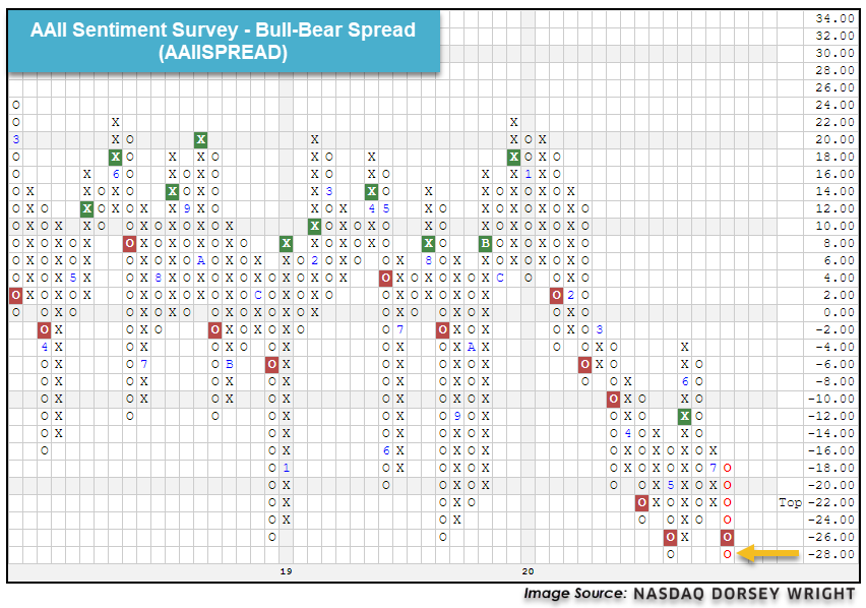Executives at public companies are conditioned to make data-dependent decisions. This is a valuable mindset to be in, especially in our current investment environment. It feels a bit like the stock market is disconnected from the economy. In fact, many are waiting for the other shoe to drop — just look at the AAII Sentiment Survey I’ve shared below.
I have many of the same feelings that I hear executives voice daily. Even if they are looking to get some cash deployed, they still want a substantial pullback. But U.S. capital markets haven’t given us that opportunity since March 23, when the S&P 500 index hit bottom. But I still believe the glass is half full, not half empty like many seem to think.
Let me add some data to your decision-making process. The stock market could certainly be ahead of itself on a short-term basis and will suffer periodic difficulties. However, stocks are feasting on. They’re likely to continue being supported by some major, favorable forces: cautious investors, massive policy support, a bouncing economy, and one of the biggest economic divots ever experienced in U.S. history.
This blog is the first part of a trilogy that discusses the current context of the market. The three points I discuss are, in order, as follows:
The case made throughout this series is that there is a lot of “dry powder” sitting in money market and low-volatility strategies in protectionist portfolios. This dry powder is the fuel that has historically supported higher equity prices — but not for every sector. The separation between the current winners and losers of the subsectors in the S&P 500 is growing wider. Now may be a more important time than ever to concentrate on your exposure rather than diversify your portfolio performance.
Consider one final glass-half-full thought: liquidity. As you take equity risk, it’s paramount to know your family’s liquidity requirements for the next one to three years. If there is a delta between your expected cash flow and liquidity needed, raise that cash now and park it in money market or another lower volatility investment. Keep in mind that your incentive compensation and annual bonus can be impacted in the intermediate term, requiring higher liquidity at this time. This will supplement your lifestyle for up to the next three years and allow you to take risk with your investment capital from a position of balance sheet strength.
Never allow yourself to be fragile during market or economic disruption — it’s not worth it. Consider the following AAII Sentiment Survey and its indications on the current market:
Blog: Source: Dorsey Wright
The most recent American Association of Individual Investors (AAII) Sentiment Survey figures were released Thursday, revealing a sharp uptick in individuals that feel bearish on equity markets in the near future. We have developed secondary readings/charts for each of these using a four-week average to smooth the readings. Since the poll began in 1987, the AAII Sentiment Survey is conducted each week from Thursday 12:01 a.m. until Wednesday at 11:59 p.m. and aims to measure the percentage of investors who are bullish, bearish, or neutral on the stock market in the short-term (Source: aaii.com).
The AAII Bull-Bear Spread depicts the percentage of those that are bullish in their market outlook minus those that are bearish. Based on Thursday’s survey results, 20% of respondents were bullish while 48% of respondents were bearish, leading to a spread reading of -28%. This caused the indicator to reverse back down, matching low levels seen in May before the broad domestic equity rally continued in June. Prior to that time, the indicator had not seen such low levels since February of 2016.




While I don’t know if our solutions would be a fit in your unique situation, I’ve got some ideas and best practices I’ve seen work well for executives like you. If you’re interested in learning more about them, let’s set up a brief, introductory call so I can learn about you. Then we’ll see whether it makes sense to schedule a demo. You can also click here to learn more about Nasdaq Dorsey Wright.
Keep in mind that individuals cannot invest directly in any index, and index performance does not include transaction costs or other fees, which will affect actual investment performance. Individual investor’s results will vary. Past performance does not guarantee future results. Investing involves risk regardless of the strategy selected. Opinions expressed are those of the author and not necessarily those of Raymond James. There is no guarantee that these statements, opinions or forecasts provided herein will prove to be correct.
The attached research DJIA research report was prepared and published by a third party and is being provided to you by Raymond James Financial Services, Inc. solely for informative purposes. Any person receiving this report from Raymond James Financial Services, Inc. and/or its affiliates should direct all questions and requests for additional information to their financial advisors and may not contact any analyst or representative of the third-party research provider. Neither Raymond James Financial Services, Inc. nor any third-party research provider is responsible for any action or inaction you may take as a result of reviewing this report or for the consequences of said action or inaction.
Any information is not a complete summary or statement of all available data necessary for making an investment decision and does not constitute a recommendation. Past performance is not a guarantee of future results.
The Dow Jones Industrial Average (DJIA), commonly known as “The Dow,” is an index representing the stocks of 30 companies maintained and reviewed by the editors of the Wall Street Journal.
The S&P 500 is an unmanaged index of 500 widely held stocks that is generally considered representative of the U.S. stock market.
The NASDAQ-100 (^NDX) is a stock market index made up of 103 equity securities issued by 100 of the largest nonfinancial companies listed on the NASDAQ. It is a modified capitalization-weighted index. … It is based on exchange, and it is not an index of U.S.-based companies.
The information has been obtained from sources considered to be reliable, but we do not guarantee that the foregoing material is accurate or complete.






